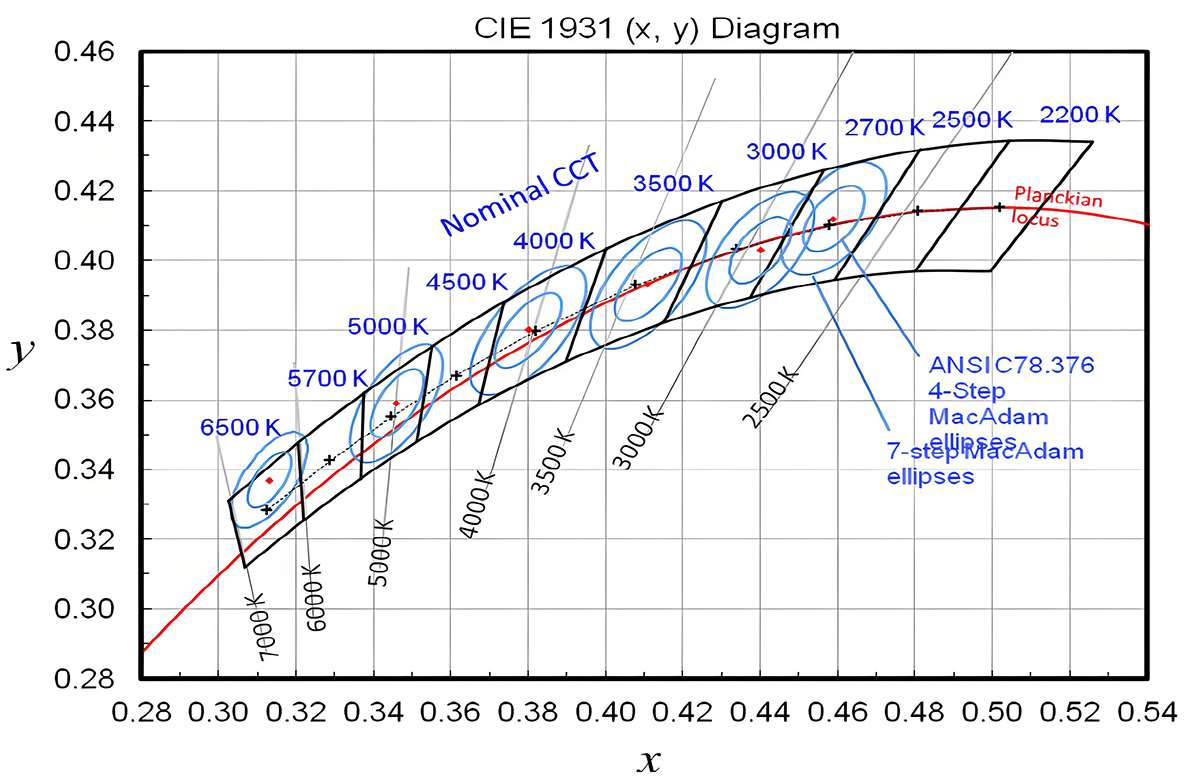LED Binning
2025-05-06
LED Binning
Ever noticed how some LED strips shine uniformly while others show subtle colour shifts? That’s LED binning at work — a crucial process that ensures consistency, performance, and quality in LED lighting.
What is LED Binning?
LED binning is the systematic sorting of manufactured LEDs based on their performance characteristics. After production, LEDs naturally exhibit variations in key parameters like colour temperature, brightness, and forward voltage – even those from the same manufacturing batch. Binning categorises these LEDs into groups (or "bins") with similar performance profiles, ensuring consistency in lighting applications.
Why LED Binning Matters
Imagine installing an LED strip along your kitchen countertop, only to discover a jarring patchwork of slightly different whites. Or worse, implementing a circadian rhythm lighting system where inconsistent colour temperatures disrupt rather than support natural sleep patterns. These scenarios illustrate why binning is critical:
Visual Consistency: Ensures uniform appearance across lighting installations
Predictable Performance: Delivers reliable colour rendering and brightness
Circadian Applications: Enables precise wavelength control for human-centric lighting
Design Integrity: Preserves the intended aesthetic and functional experience
Without effective binning, the inherent manufacturing variations in LEDs would make consistent, quality lighting virtually impossible.
How LED Binning Works
The binning process involves several key steps:
Manufacturing: LEDs are produced in large batches
Testing: Each LED undergoes automated testing for multiple parameters
Categorisation: Based on test results, LEDs are sorted into bins
Labelling: Bins receive standardised codes indicating their specifications
Quality Control: The QC team will examine the batch and check it for potential defects, to ensure the batch hits the quality standards.
Selection: Manufacturers and lighting designers select appropriate bins for specific applications
Key Parameters for Binning
LEDs are primarily binned according to:
Colour Temperature/Chromaticity: Measured on the CIE colour space and expressed in Kelvins for white LEDs
Luminous Flux: The total brightness output, measured in lumens
Forward Voltage: The electrical characteristic determining power consumption
Binning Standards and MacAdam Ellipses
The industry uses MacAdam ellipses to define colour consistency. These elliptical regions on the CIE chromaticity diagram represent colour differences barely perceptible to the human eye:
1-2 step MacAdam: Virtually imperceptible differences (highest quality)
3 step MacAdam: Minor variations detectable only by trained observers
4-7 step MacAdam: Variations noticeable to average observers
>7 step MacAdam: Clearly visible differences (lowest quality)
Premium lighting applications typically use 3-step or better, while economic solutions might use 5 step binning.
Regulatory Frameworks: ANSI Dominance and Global Standards
The American National Standards Institute (ANSI) C78.377 has become the global benchmark for LED binning due to its precise alignment with the black body locus, historical timing, and manufacturing practicality. When LED technology advanced in the early 2000s, East Asian manufacturers — closely tied to U.S. tech firms — adopted ANSI’s 2008 chromaticity standard, which closely followed the black body locus for more accurate colour representation. In contrast, Europe’s IEC developed a more flexible framework that lacked the clear compliance metrics manufacturers preferred.
ANSI’s quadrangle method balanced production realities with visual consistency, making it simpler and more cost-effective for mass production. As most LED chips were produced in Asia, aligning with ANSI streamlined supply chains and simplified global distribution. With North America being a major market, ANSI became the default — even for products bound for Europe.
Who Benefits from LED Binning?
Manufacturers: Binning allows LED manufacturers to maximise yield by finding applications for all produced LEDs rather than discarding those that don't meet strict specifications.
Lighting Designers: Designers rely on binned LEDs to ensure their lighting plans deliver consistent results, especially in architectural and commercial applications where uniformity is paramount.
End Users: From homeowners installing LED strips to healthcare facilities implementing circadian lighting, end users benefit from predictable, consistent lighting experiences.
The Economics of LED Binning
Binning creates a natural price hierarchy for LEDs:
Tighter Bins (higher consistency) = Higher prices
Looser Bins (greater variation) = Lower prices
This economic reality means that applications requiring the highest consistency (like high end lighting projects) will inherently cost more than general illumination products.
For LED strip manufacturers, binning decisions directly impact both product quality and pricing strategy. Premium strips advertise tight binning specifications, while budget options often use wider bins.
The Future of LED Binning: Several trends are shaping the future of LED binning:
Manufacturing Improvements: Advanced production techniques are gradually reducing variation in LED characteristics, potentially narrowing bin ranges naturally.
Automated Intelligent Binning: AI and machine learning are beginning to optimise the binning process, identifying subtle patterns in LED characteristics that weren't previously detectable.
Standardisation Evolution: Industry standards continue to evolve, with increasing pressure for clearer consumer-facing information about binning specifications.
Best Practices for Working with Binned LEDs
For professionals working with LED strips and circadian applications:
Sourcing Strategy: Purchase all LEDs for a project from the same bin when possible
Documentation: Maintain records of bin specifications for future matching
Testing: Verify bin claims through independent measurements for critical applications
Application-Appropriate Selection: Choose binning precision based on the specific requirements
Conclusion
LED binning might seem like a technical detail, but it's actually the foundation upon which quality lighting experiences are built. For those of us working with LEDs in a variety of applications, understanding binning isn't just academic—it's essential to delivering solutions that perform as promised.



